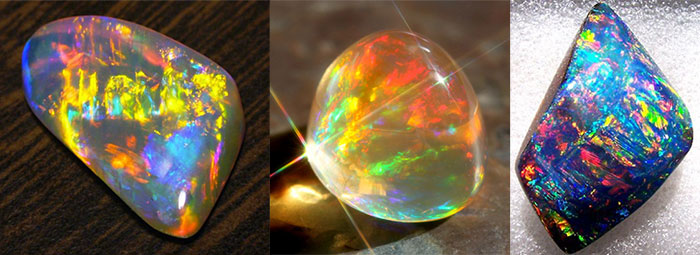Opal gemstone
Home ➤ Encyclopedia of gems ➤ Opal gemstonePhysical properties of opal
| Hardness: | 5.5-6.5 out of 10 on the Mohs scale |
| Luster: | glassy, sometimes mother-of-pearl |
| Transparency: | transparent, translucent |
| Color: | white, yellow, red, orange, brown, blue, green, black |
Characteristics of opal
Opal (noble opal, crackling, harlequin, girazole, royal opal, hydrophane, hyalite) is a very unusual mineral.
Surprisingly, opal is translated from Sanskrit (“upala”) and means “precious stone” (or “gem”). So opal can honestly admit that it is a real gem. Even by name.

First of all, the unusualness of this gemstone is that some opals can absorb water, and then, when the water evaporates, the opal cracks. That is why this stone was called "crack" in ancient times. The second unusual thing about opal is that there are so many varieties of this stone that simply listing them is enough for a whole book. However, scientists decided to break all the opals into main subgroups in order to somehow classify this unusual gem.
Among the huge variety of opals, only the so-called "noble opals" are valued by jewelers. Such stones are distinguished by a characteristic play of color - opalescence. Black opals are considered the most beautiful and expensive. And the most unusual noble opals are "harlequins". Harlequin is an opal with a motley mosaic pattern, glaring in a variety of colors: red, yellow, blue and green. Pale milky opal with blue highlights or colorless opal with red highlights is called "girazol" ("girazol"), which is translated from Italian as "sun-rotation". Royal opal is called with a dark red, purple (rarely bronze) center and a bright green border. Hydrophanes are also interesting - opals, which, when placed in water, become translucent. A colorless opal that looks like glass is called hyalite. There are also noble white, fire opals, chrysopals (green opals). And many others.
Varieties of noble opals:
- white opals - opals with a light base and iridescent play of color
- black opals - opals with a dark base and iridescent play of color
- cat-eye opals - bright green opals whose multi-colored sparkles fold into a running streak of light that resembles a cat's eye
- fire opals - transparent and translucent opals from hyacinth red to wine yellow, may have opalescence, the only opals that are cut
- harlequins - opals with mosaic opalescence, each part has a clear border and differs in the play of color from other parts
- girazols - translucent opals with a pale milky base and a blurry play of color (usually blue and red shades)
- lexos opals - green opals with a play of green and carmine
- boulder opals - opals with a brown base and opalescent veins
- royal opals - opals with a dark red, purple or bronze center and bright green edges
- sparkling opals - opals with small sparkles
Varieties of ordinary opals:
- milk opals - opaque opals of white, yellowish or bluish color
- wax opals - pale yellow-brown opals with a shiny, waxy surface
- hyalites - water-transparent opals with weakly expressed opalescence
- jelly opals (water opals, hydrofans) - porous opals, which, when saturated with water, become translucent with a beautiful play of colors
- irisopals - colorless or brownish opals with a single color tint (mined in Mexico)
- cacholongs (pearl opals) - milky white opaque opals with a pearly sheen
- prazopals (chrysopal) - opaque apple-green or yellow-green opals
- Peruvian opals (blue opals) - bluish-green and blue opals without pronounced color highlights (mined in Peru)
Opal is a precious stone that requires special attention. Loss of water, contact with various oils and fats can cause the stone to lose its unusual luster - opalescence. To avoid this, it is necessary to protect the opal from contact with cosmetics and periodically lower the opal into water.
Since ancient times, opal has been highly valued by people. And this was often used by various swindlers and swindlers, passing off fakes made of glass as opals. However, the complex play of light (opalescence) of real opal is very difficult to create even under current conditions.
One very unusual story is connected with opal. The fact is that somewhere in the middle of the 19th century, the demand for opals drops sharply. And it happened because of ... the novel by W. Scott "Karl the Bold, or Anna Geyersteinskaya, Maiden of Gloom", which mentions one noble opal. And although in the mysterious story of the author, opal is not at all served as a negative hero, nevertheless, women's society is imbued with negativity towards this precious stone, and opals go out of fashion.
However, not for long. Now opal is again very much loved. And this extraordinarily beautiful stone cannot leave anyone indifferent.
How much is opal
Valuing opals is very difficult. After all, the price is determined by the color scheme, color play, brilliance, size, rarity, even a special structure invisible to the ordinary eye.
In addition, the price for each opal is set by special appraisers-jewelers, and sometimes even for the same opal, different appraisers can offer very different prices.
The most expensive are Australian black opals with a pronounced play of color. Opals with the optical effect of a cat's eye are valued above all.
| ★ Aventurine gemstone | |
| See also: | ★ Ruby gemstone |
| ★ Morganite gemstone |





